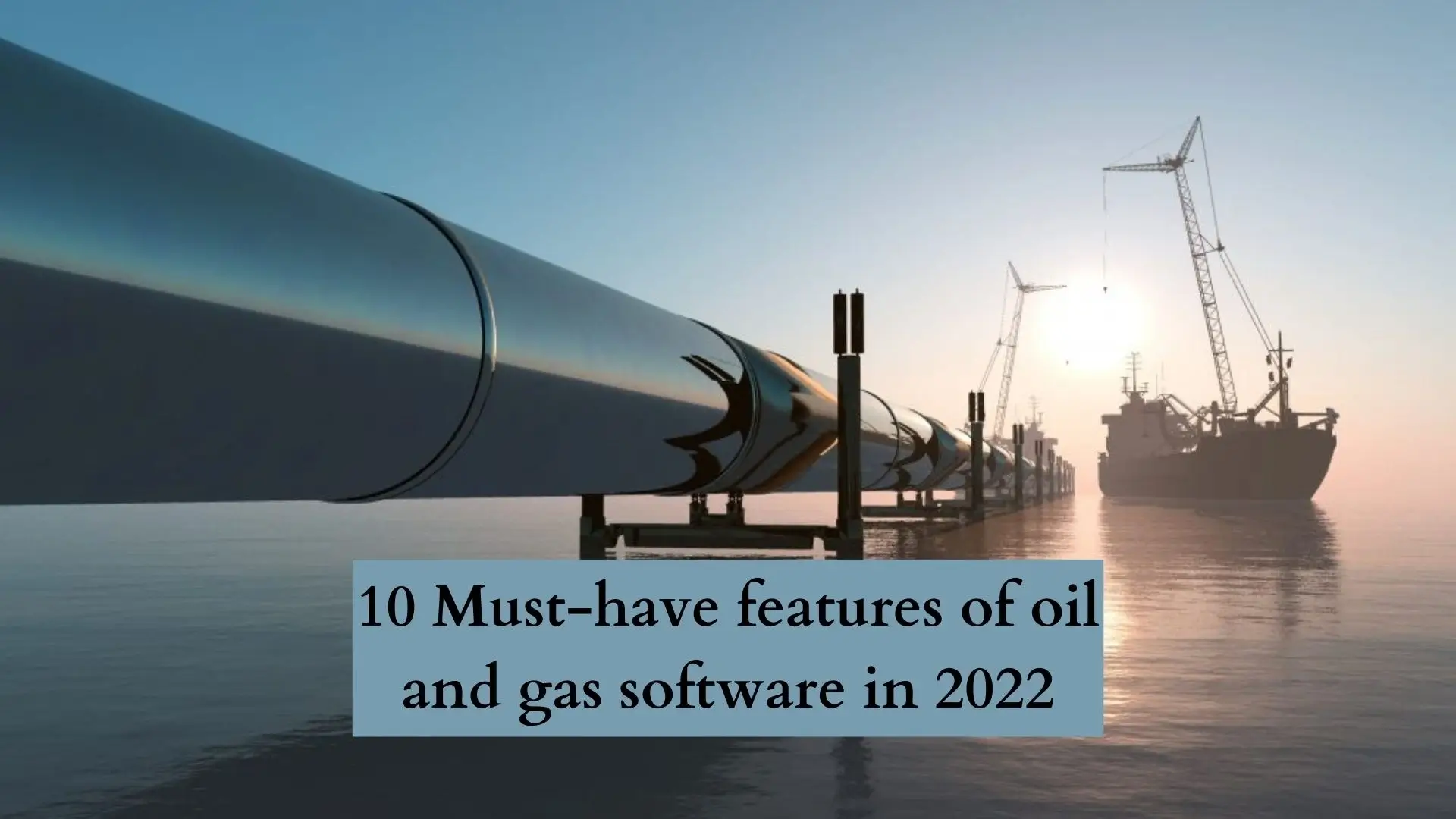Many oil and gas businesses are attempting to reinvent themselves as we approach 2022 by adopting capital discipline, concentrating on financial health, committing to climate change, and changing business models. The industry’s transformation path has just begun, and merely managing or riding oil price cycles is no longer an option. 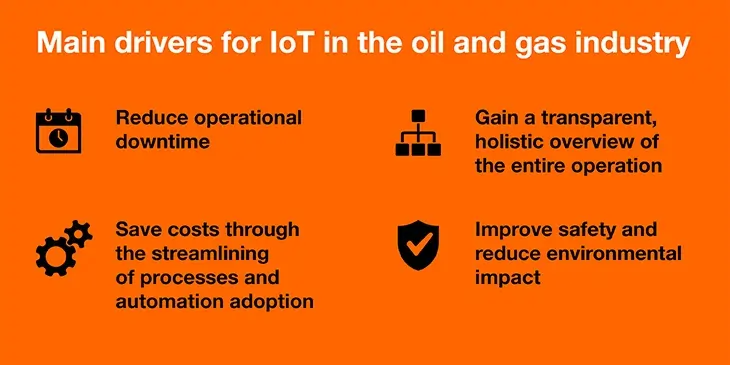 The oil and gas (O&G) sector trends are poised to alter the industry in terms of efficiency, safety, and smart solutions, thanks to improvements in industry 4.0 technologies. The oil and gas sector is looking for solutions to digitize, automate, and solve difficult subsurface engineering issues cost-effectively and competitively. Artificial intelligence (AI) algorithms help oil and gas firms boost field or well production and offer a competitive advantage. Furthermore, the growing deployment of advanced robots and data management procedures encourages scientists to devise new methods for reducing human labor and speeding up processing times.
The oil and gas (O&G) sector trends are poised to alter the industry in terms of efficiency, safety, and smart solutions, thanks to improvements in industry 4.0 technologies. The oil and gas sector is looking for solutions to digitize, automate, and solve difficult subsurface engineering issues cost-effectively and competitively. Artificial intelligence (AI) algorithms help oil and gas firms boost field or well production and offer a competitive advantage. Furthermore, the growing deployment of advanced robots and data management procedures encourages scientists to devise new methods for reducing human labor and speeding up processing times.
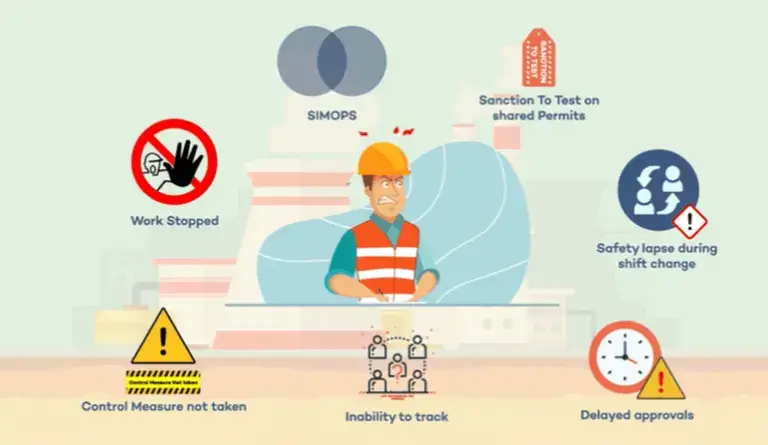 Even in regular times, oil and gas sector executives must manage complicated operations, including a large number of people, several teams and locations, a large amount of safety and compliance documentation, and a large number of employees. However, the year 2020 presented the sector with even more new obstacles. Furthermore, statistics reveal that at least two-thirds of all workers presently work remotely, with many of them planning to remain remote and decentralized in the future. In addition, they frequently work in big groups and across departments. Keeping everyone in the loop becomes extremely difficult in these circumstances. That is why COVID-19 has taken workers online and educated employees worldwide on a new digital approach to preserve corporate balance and productivity, and effective communication among employees even when they are apart. Employees in the energy and materials industries are no exception to this rule. O&G strategists should do the following in the next 12 to 18 months:
Even in regular times, oil and gas sector executives must manage complicated operations, including a large number of people, several teams and locations, a large amount of safety and compliance documentation, and a large number of employees. However, the year 2020 presented the sector with even more new obstacles. Furthermore, statistics reveal that at least two-thirds of all workers presently work remotely, with many of them planning to remain remote and decentralized in the future. In addition, they frequently work in big groups and across departments. Keeping everyone in the loop becomes extremely difficult in these circumstances. That is why COVID-19 has taken workers online and educated employees worldwide on a new digital approach to preserve corporate balance and productivity, and effective communication among employees even when they are apart. Employees in the energy and materials industries are no exception to this rule. O&G strategists should do the following in the next 12 to 18 months:
 Oil and gas firms use these data to identify malfunctioning equipment and to respond quickly. IoT technologies are used to save maintenance costs and obtain deep visibility into their equipment and operations. Artificial Intelligence (AI) Artificial Intelligence and data science are rapidly used in the oil and gas sector to address difficult challenges in upstream, middle, and downstream operations. Predictive, prescriptive, and cognitive analytics are all supported by AI-enabled systems, which aid decision-making.
Oil and gas firms use these data to identify malfunctioning equipment and to respond quickly. IoT technologies are used to save maintenance costs and obtain deep visibility into their equipment and operations. Artificial Intelligence (AI) Artificial Intelligence and data science are rapidly used in the oil and gas sector to address difficult challenges in upstream, middle, and downstream operations. Predictive, prescriptive, and cognitive analytics are all supported by AI-enabled systems, which aid decision-making. 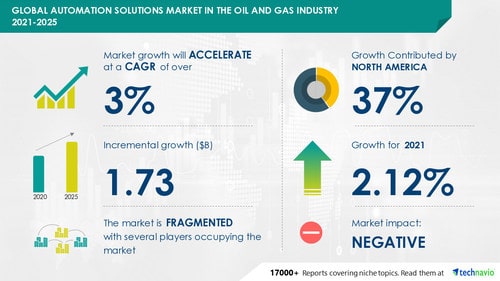 To boost ROI in the oil & gas industry, AI helps petroleum engineers and production managers develop and implement innovative exploration and production concepts. Big Data & Analytics Large amounts of unstructured data are generated daily in the oil and gas business. Big data platforms aid data analysts in extracting insights from production and performance data in the industry. Engineers who want to maximize production and keep reservoirs safe will find this useful. Additionally, historical data from prior operations helps AI-driven algorithms and models be properly trained and tested. The oil and gas sector can get more value from everyday choices by utilizing big data analytics to lower operating costs and carbon emissions. Automation & Robotics Operators in the oil and gas industry typically work in dangerous and difficult environments, putting their lives in danger. The oil sector uses robotics technologies that improve worker safety while increasing operational speed. In oil rigs and refineries, robots are also helpful for inspection, surveying, and industrial automation. Robotics and process automation speed up processes and reduce the labor required, resulting in increased efficiency and fewer human-caused mistakes. Visualization and 3D modeling Realistic representations of underground reservoirs and other O&G equipment may be created using 3D modeling and high-quality visuals. When combined with historical production data, 3D modeling mimics a reservoir’s production and injection stages. This aids in the prediction of dangers to the reservoir’s safety. Oil and gas engineers optimize production and operations planning based on the data. In addition, 3D modeling and visualization decrease costs and risks while improving the performance of oil and gas assets. Cloud Computing Cloud computing allows storing and processing data on remote servers, freeing up costly local memory and computational resources. In its everyday operations, the oil and gas sector creates massive volumes of data.
To boost ROI in the oil & gas industry, AI helps petroleum engineers and production managers develop and implement innovative exploration and production concepts. Big Data & Analytics Large amounts of unstructured data are generated daily in the oil and gas business. Big data platforms aid data analysts in extracting insights from production and performance data in the industry. Engineers who want to maximize production and keep reservoirs safe will find this useful. Additionally, historical data from prior operations helps AI-driven algorithms and models be properly trained and tested. The oil and gas sector can get more value from everyday choices by utilizing big data analytics to lower operating costs and carbon emissions. Automation & Robotics Operators in the oil and gas industry typically work in dangerous and difficult environments, putting their lives in danger. The oil sector uses robotics technologies that improve worker safety while increasing operational speed. In oil rigs and refineries, robots are also helpful for inspection, surveying, and industrial automation. Robotics and process automation speed up processes and reduce the labor required, resulting in increased efficiency and fewer human-caused mistakes. Visualization and 3D modeling Realistic representations of underground reservoirs and other O&G equipment may be created using 3D modeling and high-quality visuals. When combined with historical production data, 3D modeling mimics a reservoir’s production and injection stages. This aids in the prediction of dangers to the reservoir’s safety. Oil and gas engineers optimize production and operations planning based on the data. In addition, 3D modeling and visualization decrease costs and risks while improving the performance of oil and gas assets. Cloud Computing Cloud computing allows storing and processing data on remote servers, freeing up costly local memory and computational resources. In its everyday operations, the oil and gas sector creates massive volumes of data. 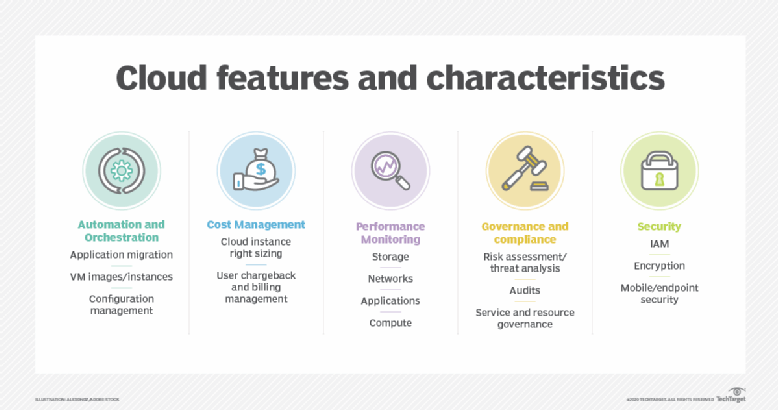 Cloud computing and software applications improve oil and gas efficiency, security, and scalability while facilitating digital transformation. Advanced analytics, informative visual dashboards, and remote access to real-time insights are possible with cloud-native technologies such as software-as-a-service platforms – platform, storage, infrastructure, data, and more. Technology-based on Reality Immersive technologies (XR) include virtual reality (VR), augmented reality (AR), mixed reality (MR), and extended reality (ER). AR/VR animations improve productivity and decrease mistakes in the oil and gas sector by displaying real-time information regarding equipment, tools, and parts. For remote monitoring, downhole imaging, and virtual training, exploration, and production (E&P), businesses, for example, deploy reality solutions. Furthermore, entrepreneurs use wearables and smartphone notifications to allow human-machine interactions by combining real and virtual environments. Systems for Manufacturing Execution (MES) MES incorporates manufacturing facilities, operational technologies such as supervisory control and data acquisition (SCADA), and computing systems to regulate the production process. Engineers seek methods to monitor and regulate the continuous operating processes in oil and gas equipment manufacture since the operations are complicated. With MES’ intelligent design and integrated control, oil and gas production systems can be made faster, safer, and more reliable. Predictive Maintenance Predictive maintenance and operations involve gathering data from sensors in field installations and combining it with machine learning algorithms. Engineers can swiftly analyze equipment issues and provide timely maintenance solutions. Predictive operations allow detailed component visualizations combined with software systems, allowing O&G operators to anticipate future breakdowns. Furthermore, predictive maintenance has applications in all activities, including upstream, midstream, and downstream. These solutions increase safety, extend the life of installations, and save operational and maintenance expenses. Blockchain Blockchain is making inroads into various industries, including oil and gas. Smart contracts provide oil and gas documents and operations much-needed security and transparency. Distributed ledgers are used to authenticate contractors and workers and keep smart contracts.
Cloud computing and software applications improve oil and gas efficiency, security, and scalability while facilitating digital transformation. Advanced analytics, informative visual dashboards, and remote access to real-time insights are possible with cloud-native technologies such as software-as-a-service platforms – platform, storage, infrastructure, data, and more. Technology-based on Reality Immersive technologies (XR) include virtual reality (VR), augmented reality (AR), mixed reality (MR), and extended reality (ER). AR/VR animations improve productivity and decrease mistakes in the oil and gas sector by displaying real-time information regarding equipment, tools, and parts. For remote monitoring, downhole imaging, and virtual training, exploration, and production (E&P), businesses, for example, deploy reality solutions. Furthermore, entrepreneurs use wearables and smartphone notifications to allow human-machine interactions by combining real and virtual environments. Systems for Manufacturing Execution (MES) MES incorporates manufacturing facilities, operational technologies such as supervisory control and data acquisition (SCADA), and computing systems to regulate the production process. Engineers seek methods to monitor and regulate the continuous operating processes in oil and gas equipment manufacture since the operations are complicated. With MES’ intelligent design and integrated control, oil and gas production systems can be made faster, safer, and more reliable. Predictive Maintenance Predictive maintenance and operations involve gathering data from sensors in field installations and combining it with machine learning algorithms. Engineers can swiftly analyze equipment issues and provide timely maintenance solutions. Predictive operations allow detailed component visualizations combined with software systems, allowing O&G operators to anticipate future breakdowns. Furthermore, predictive maintenance has applications in all activities, including upstream, midstream, and downstream. These solutions increase safety, extend the life of installations, and save operational and maintenance expenses. Blockchain Blockchain is making inroads into various industries, including oil and gas. Smart contracts provide oil and gas documents and operations much-needed security and transparency. Distributed ledgers are used to authenticate contractors and workers and keep smart contracts. 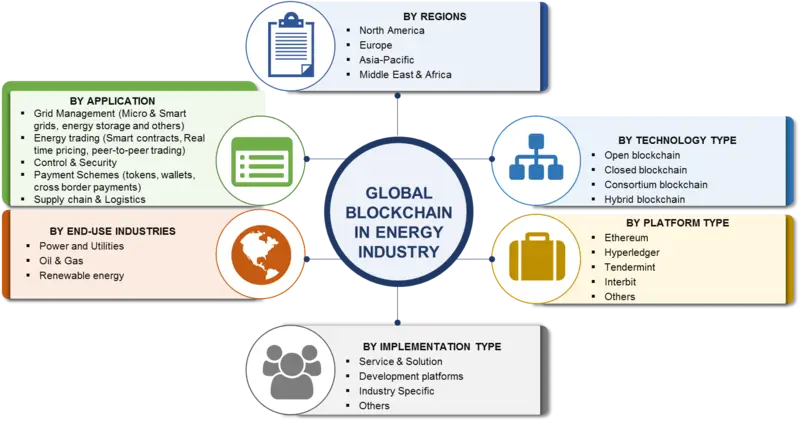 Oil and gas firms may also use Blockchain to manage invoicing, post-trade settlements, and joint venture accounting. Hydrocarbon fleet tracking, trade, retail B2C, and intragroup billing can all benefit from Blockchain.
Oil and gas firms may also use Blockchain to manage invoicing, post-trade settlements, and joint venture accounting. Hydrocarbon fleet tracking, trade, retail B2C, and intragroup billing can all benefit from Blockchain.
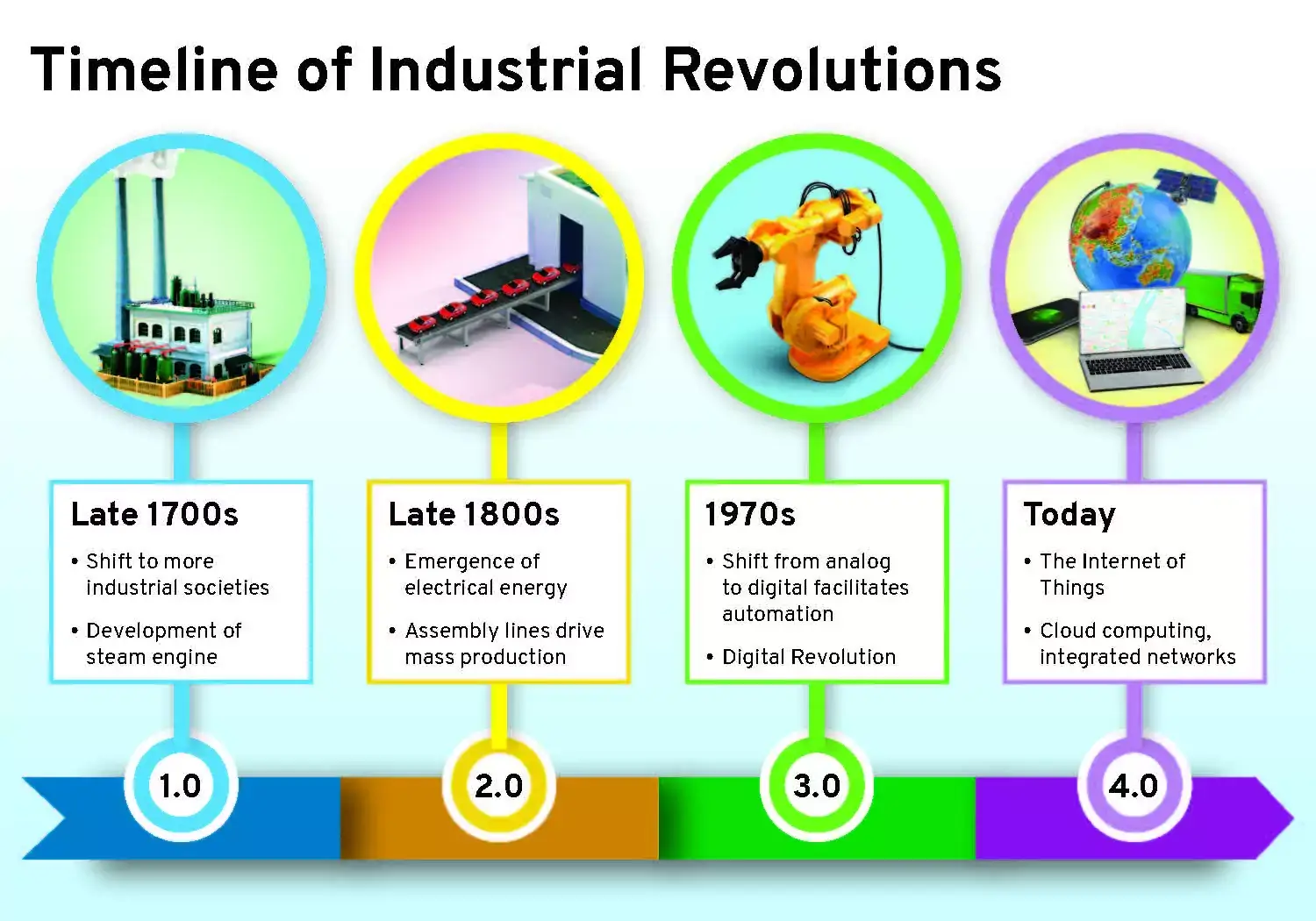 The main purpose of oil and gas business software is to automate personnel management in the oil and gas sector and ensure efficient operations along the full workforce chain, from exploration to distribution. Employee management applications save time and money for oil and gas companies by:
The main purpose of oil and gas business software is to automate personnel management in the oil and gas sector and ensure efficient operations along the full workforce chain, from exploration to distribution. Employee management applications save time and money for oil and gas companies by:
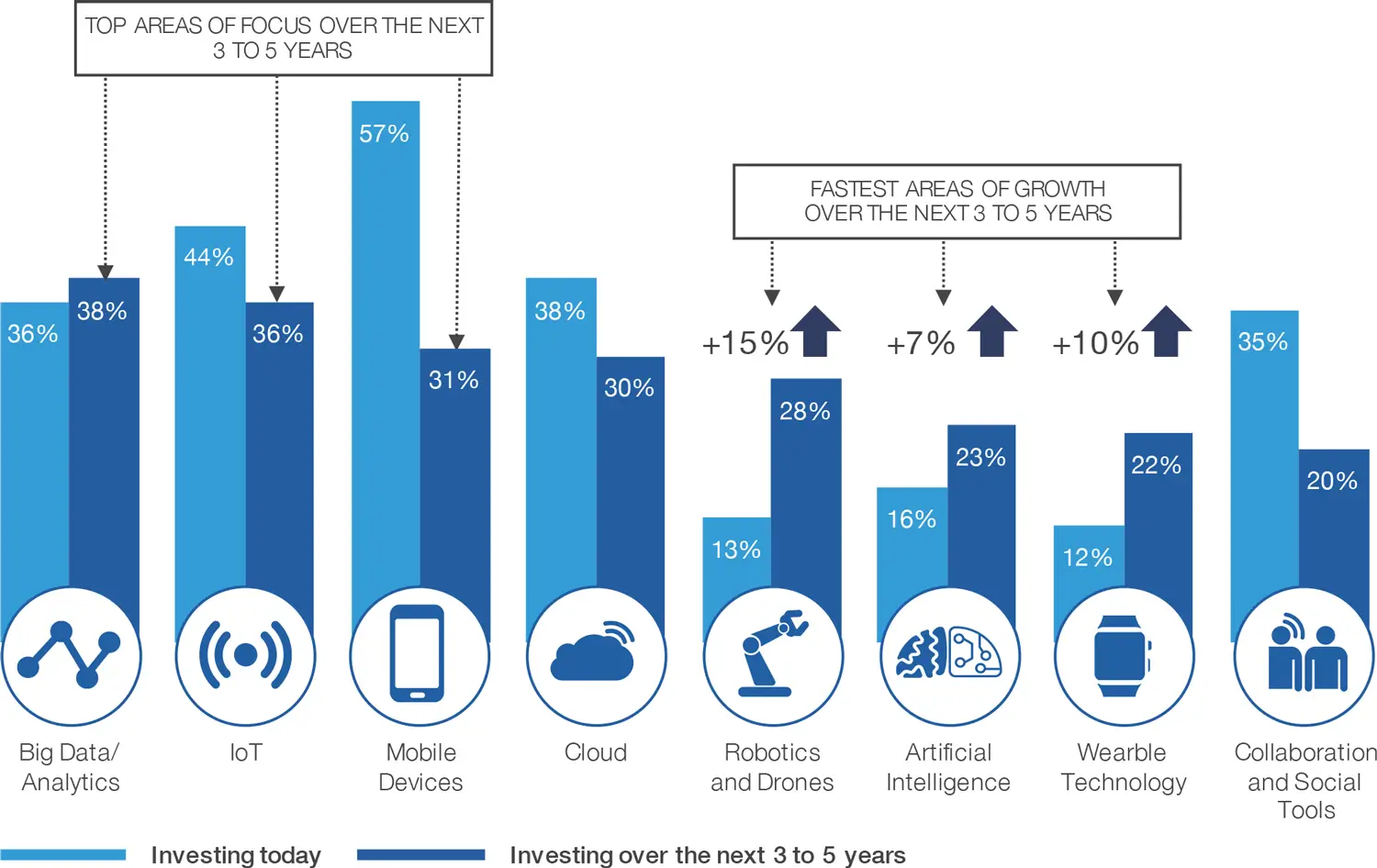 Adapting to new technology assists oil and gas operators and enterprises in addressing new difficulties and moving forward. Furthermore, the COVID-19 epidemic has compelled industrial businesses to reconsider their daily operations. This report’s Oil & Gas Industry Patterns & Startups scratch the surface of the trends we discovered throughout our extensive investigation. For example, AI, Big Data, and Robotics will alter the industry as we know it today. Early identification of new prospects and developing technology to incorporate into your organization might help you acquire a competitive advantage. Contact us to quickly and thoroughly investigate key technologies and startups that interest you.
Adapting to new technology assists oil and gas operators and enterprises in addressing new difficulties and moving forward. Furthermore, the COVID-19 epidemic has compelled industrial businesses to reconsider their daily operations. This report’s Oil & Gas Industry Patterns & Startups scratch the surface of the trends we discovered throughout our extensive investigation. For example, AI, Big Data, and Robotics will alter the industry as we know it today. Early identification of new prospects and developing technology to incorporate into your organization might help you acquire a competitive advantage. Contact us to quickly and thoroughly investigate key technologies and startups that interest you.
 The oil and gas (O&G) sector trends are poised to alter the industry in terms of efficiency, safety, and smart solutions, thanks to improvements in industry 4.0 technologies. The oil and gas sector is looking for solutions to digitize, automate, and solve difficult subsurface engineering issues cost-effectively and competitively. Artificial intelligence (AI) algorithms help oil and gas firms boost field or well production and offer a competitive advantage. Furthermore, the growing deployment of advanced robots and data management procedures encourages scientists to devise new methods for reducing human labor and speeding up processing times.
The oil and gas (O&G) sector trends are poised to alter the industry in terms of efficiency, safety, and smart solutions, thanks to improvements in industry 4.0 technologies. The oil and gas sector is looking for solutions to digitize, automate, and solve difficult subsurface engineering issues cost-effectively and competitively. Artificial intelligence (AI) algorithms help oil and gas firms boost field or well production and offer a competitive advantage. Furthermore, the growing deployment of advanced robots and data management procedures encourages scientists to devise new methods for reducing human labor and speeding up processing times.
What Makes Oil and Gas Business Software So Important in 2022?
 Even in regular times, oil and gas sector executives must manage complicated operations, including a large number of people, several teams and locations, a large amount of safety and compliance documentation, and a large number of employees. However, the year 2020 presented the sector with even more new obstacles. Furthermore, statistics reveal that at least two-thirds of all workers presently work remotely, with many of them planning to remain remote and decentralized in the future. In addition, they frequently work in big groups and across departments. Keeping everyone in the loop becomes extremely difficult in these circumstances. That is why COVID-19 has taken workers online and educated employees worldwide on a new digital approach to preserve corporate balance and productivity, and effective communication among employees even when they are apart. Employees in the energy and materials industries are no exception to this rule. O&G strategists should do the following in the next 12 to 18 months:
Even in regular times, oil and gas sector executives must manage complicated operations, including a large number of people, several teams and locations, a large amount of safety and compliance documentation, and a large number of employees. However, the year 2020 presented the sector with even more new obstacles. Furthermore, statistics reveal that at least two-thirds of all workers presently work remotely, with many of them planning to remain remote and decentralized in the future. In addition, they frequently work in big groups and across departments. Keeping everyone in the loop becomes extremely difficult in these circumstances. That is why COVID-19 has taken workers online and educated employees worldwide on a new digital approach to preserve corporate balance and productivity, and effective communication among employees even when they are apart. Employees in the energy and materials industries are no exception to this rule. O&G strategists should do the following in the next 12 to 18 months:
- Streamline and optimize their resource portfolios
- Accept and establish smart energy transition targets
- In a tight labor market, recruit, train, and retain personnel
- Adapt to new environmental, social, and governance (ESG) criteria
These ten features should be a part of Oil and Gas software in 2022:
Internet of Things (IoT) Oil and gas companies use IoT to improve output, optimize equipment, ensure worker safety, and monitor remote locations. Through sensors installed inside wells, blowout preventers (BOP), and choke valves, real-time data can be gathered by the oil and gas companies. Oil and gas firms use these data to identify malfunctioning equipment and to respond quickly. IoT technologies are used to save maintenance costs and obtain deep visibility into their equipment and operations. Artificial Intelligence (AI) Artificial Intelligence and data science are rapidly used in the oil and gas sector to address difficult challenges in upstream, middle, and downstream operations. Predictive, prescriptive, and cognitive analytics are all supported by AI-enabled systems, which aid decision-making.
Oil and gas firms use these data to identify malfunctioning equipment and to respond quickly. IoT technologies are used to save maintenance costs and obtain deep visibility into their equipment and operations. Artificial Intelligence (AI) Artificial Intelligence and data science are rapidly used in the oil and gas sector to address difficult challenges in upstream, middle, and downstream operations. Predictive, prescriptive, and cognitive analytics are all supported by AI-enabled systems, which aid decision-making.  To boost ROI in the oil & gas industry, AI helps petroleum engineers and production managers develop and implement innovative exploration and production concepts. Big Data & Analytics Large amounts of unstructured data are generated daily in the oil and gas business. Big data platforms aid data analysts in extracting insights from production and performance data in the industry. Engineers who want to maximize production and keep reservoirs safe will find this useful. Additionally, historical data from prior operations helps AI-driven algorithms and models be properly trained and tested. The oil and gas sector can get more value from everyday choices by utilizing big data analytics to lower operating costs and carbon emissions. Automation & Robotics Operators in the oil and gas industry typically work in dangerous and difficult environments, putting their lives in danger. The oil sector uses robotics technologies that improve worker safety while increasing operational speed. In oil rigs and refineries, robots are also helpful for inspection, surveying, and industrial automation. Robotics and process automation speed up processes and reduce the labor required, resulting in increased efficiency and fewer human-caused mistakes. Visualization and 3D modeling Realistic representations of underground reservoirs and other O&G equipment may be created using 3D modeling and high-quality visuals. When combined with historical production data, 3D modeling mimics a reservoir’s production and injection stages. This aids in the prediction of dangers to the reservoir’s safety. Oil and gas engineers optimize production and operations planning based on the data. In addition, 3D modeling and visualization decrease costs and risks while improving the performance of oil and gas assets. Cloud Computing Cloud computing allows storing and processing data on remote servers, freeing up costly local memory and computational resources. In its everyday operations, the oil and gas sector creates massive volumes of data.
To boost ROI in the oil & gas industry, AI helps petroleum engineers and production managers develop and implement innovative exploration and production concepts. Big Data & Analytics Large amounts of unstructured data are generated daily in the oil and gas business. Big data platforms aid data analysts in extracting insights from production and performance data in the industry. Engineers who want to maximize production and keep reservoirs safe will find this useful. Additionally, historical data from prior operations helps AI-driven algorithms and models be properly trained and tested. The oil and gas sector can get more value from everyday choices by utilizing big data analytics to lower operating costs and carbon emissions. Automation & Robotics Operators in the oil and gas industry typically work in dangerous and difficult environments, putting their lives in danger. The oil sector uses robotics technologies that improve worker safety while increasing operational speed. In oil rigs and refineries, robots are also helpful for inspection, surveying, and industrial automation. Robotics and process automation speed up processes and reduce the labor required, resulting in increased efficiency and fewer human-caused mistakes. Visualization and 3D modeling Realistic representations of underground reservoirs and other O&G equipment may be created using 3D modeling and high-quality visuals. When combined with historical production data, 3D modeling mimics a reservoir’s production and injection stages. This aids in the prediction of dangers to the reservoir’s safety. Oil and gas engineers optimize production and operations planning based on the data. In addition, 3D modeling and visualization decrease costs and risks while improving the performance of oil and gas assets. Cloud Computing Cloud computing allows storing and processing data on remote servers, freeing up costly local memory and computational resources. In its everyday operations, the oil and gas sector creates massive volumes of data.  Cloud computing and software applications improve oil and gas efficiency, security, and scalability while facilitating digital transformation. Advanced analytics, informative visual dashboards, and remote access to real-time insights are possible with cloud-native technologies such as software-as-a-service platforms – platform, storage, infrastructure, data, and more. Technology-based on Reality Immersive technologies (XR) include virtual reality (VR), augmented reality (AR), mixed reality (MR), and extended reality (ER). AR/VR animations improve productivity and decrease mistakes in the oil and gas sector by displaying real-time information regarding equipment, tools, and parts. For remote monitoring, downhole imaging, and virtual training, exploration, and production (E&P), businesses, for example, deploy reality solutions. Furthermore, entrepreneurs use wearables and smartphone notifications to allow human-machine interactions by combining real and virtual environments. Systems for Manufacturing Execution (MES) MES incorporates manufacturing facilities, operational technologies such as supervisory control and data acquisition (SCADA), and computing systems to regulate the production process. Engineers seek methods to monitor and regulate the continuous operating processes in oil and gas equipment manufacture since the operations are complicated. With MES’ intelligent design and integrated control, oil and gas production systems can be made faster, safer, and more reliable. Predictive Maintenance Predictive maintenance and operations involve gathering data from sensors in field installations and combining it with machine learning algorithms. Engineers can swiftly analyze equipment issues and provide timely maintenance solutions. Predictive operations allow detailed component visualizations combined with software systems, allowing O&G operators to anticipate future breakdowns. Furthermore, predictive maintenance has applications in all activities, including upstream, midstream, and downstream. These solutions increase safety, extend the life of installations, and save operational and maintenance expenses. Blockchain Blockchain is making inroads into various industries, including oil and gas. Smart contracts provide oil and gas documents and operations much-needed security and transparency. Distributed ledgers are used to authenticate contractors and workers and keep smart contracts.
Cloud computing and software applications improve oil and gas efficiency, security, and scalability while facilitating digital transformation. Advanced analytics, informative visual dashboards, and remote access to real-time insights are possible with cloud-native technologies such as software-as-a-service platforms – platform, storage, infrastructure, data, and more. Technology-based on Reality Immersive technologies (XR) include virtual reality (VR), augmented reality (AR), mixed reality (MR), and extended reality (ER). AR/VR animations improve productivity and decrease mistakes in the oil and gas sector by displaying real-time information regarding equipment, tools, and parts. For remote monitoring, downhole imaging, and virtual training, exploration, and production (E&P), businesses, for example, deploy reality solutions. Furthermore, entrepreneurs use wearables and smartphone notifications to allow human-machine interactions by combining real and virtual environments. Systems for Manufacturing Execution (MES) MES incorporates manufacturing facilities, operational technologies such as supervisory control and data acquisition (SCADA), and computing systems to regulate the production process. Engineers seek methods to monitor and regulate the continuous operating processes in oil and gas equipment manufacture since the operations are complicated. With MES’ intelligent design and integrated control, oil and gas production systems can be made faster, safer, and more reliable. Predictive Maintenance Predictive maintenance and operations involve gathering data from sensors in field installations and combining it with machine learning algorithms. Engineers can swiftly analyze equipment issues and provide timely maintenance solutions. Predictive operations allow detailed component visualizations combined with software systems, allowing O&G operators to anticipate future breakdowns. Furthermore, predictive maintenance has applications in all activities, including upstream, midstream, and downstream. These solutions increase safety, extend the life of installations, and save operational and maintenance expenses. Blockchain Blockchain is making inroads into various industries, including oil and gas. Smart contracts provide oil and gas documents and operations much-needed security and transparency. Distributed ledgers are used to authenticate contractors and workers and keep smart contracts.  Oil and gas firms may also use Blockchain to manage invoicing, post-trade settlements, and joint venture accounting. Hydrocarbon fleet tracking, trade, retail B2C, and intragroup billing can all benefit from Blockchain.
Oil and gas firms may also use Blockchain to manage invoicing, post-trade settlements, and joint venture accounting. Hydrocarbon fleet tracking, trade, retail B2C, and intragroup billing can all benefit from Blockchain.
5 basic oil & gas industry apps to have in 2022
These applications may not have all of the capabilities outlined in the previous section, but they are still good options for someone in the oil and gas sector to check out and get a feel for digitizing their day-to-day operations before investing heavily in more complex technologies.Petrel E&P
This oil and gas program supports exploratory geological studies and geological modeling. It’s a cloud-based platform for the oil and gas industry that assists with features including automated workflows, uncertainty analysis, and reservoir engineering. PETREL E&P is an effective alternative for datasets containing a variety of UTM zones, but its steep learning curve makes it inaccessible to casual users who only want to edit surfaces.Connecteam
The greatest all-in-one solution for the oil and gas sector is to collect real-time information from the field, improve safety requirements, and improve internal employee communication. From digitizing reporting and processes to enabling direct connection with front-line employees, time tracking, and field staff scheduling, and more, we’ve got you covered. Managers in the oil and gas business benefit from digital workflows that automate and standardize procedures. Connecteam provides a comprehensive toolbox for communicating efficiently, managing compliance, scheduling shifts, tracking time, and organizing your organization with a single smartphone tap. Oil and gas firms also rely on the corporation for safety control, compliance, and reporting. ‘Read and sign’ forms keep employees informed and accountable. To eliminate friction and enhance reaction time, automate safety checklists and practices. Connecteam can track work hours easily, vacation and sick days can be approved on the fly, timesheets can be viewed, and more with Connecteam. You may allocate staff to different jobs using Connecteam’s scheduling software.OGsys OGpro
OGpro is an oil and gas accounting software hosted in the cloud. Accounting, document management, and payment processing are included in one program, allowing you to make the finest company decisions possible. The software can be tailored to match your needs for any nature and scale of business operation. You may track joint billing between investors and owners, manage accounts payable and receivable, and manage accounts payable and receivable. Manage taxes based on the goods and the location where it is sold. Depreciation, Depletion, and Amortization are all things to keep track of (DD&A).FieldCap
Managers may operate from any place or device with this oil and gas-specific business management software, which also features an offline option for users without an internet connection. This operational management tool ensures the safety and security of your layouts, languages, data fields, labels, and computations. Jobs, tickets, approvals, timesheets, and other forms may be managed using FieldCap. With the support of caring specialists, you can streamline your operations, reporting, and billing all in one spot.Aimsio
Aimsio is a cloud-based operations management system for field-based businesses, such as oil and gas. This app’s easy UI and robust online and mobile features can assist field personnel managers in improving operational productivity and maximizing efficiency and profits. This technology guarantees that complicated day-to-day procedures are carried out efficiently. Employee managers may use it to deploy crews and equipment, track time and materials, produce and send invoices, and interface with other tools like OpenInvoice, Cortex, or your ERP.The bottom line
 The main purpose of oil and gas business software is to automate personnel management in the oil and gas sector and ensure efficient operations along the full workforce chain, from exploration to distribution. Employee management applications save time and money for oil and gas companies by:
The main purpose of oil and gas business software is to automate personnel management in the oil and gas sector and ensure efficient operations along the full workforce chain, from exploration to distribution. Employee management applications save time and money for oil and gas companies by:
- Converting all documents to digital
- Keeping track of and archiving all of the initial data
- Lowering the number of errors
- Automating recurrent workflows.
Explore more about Oil & Gas Startups and Technologies
The oil and gas sector uses these inventions and trends to improve the efficiency of operations and workers while lowering costs. Drones and predictive maintenance have made an inspection of offshore rigs and onshore equipment much easier. Furthermore, digital twin technology allows engineers to operate remotely in hostile situations by bridging the gap between physical and virtual places. Adapting to new technology assists oil and gas operators and enterprises in addressing new difficulties and moving forward. Furthermore, the COVID-19 epidemic has compelled industrial businesses to reconsider their daily operations. This report’s Oil & Gas Industry Patterns & Startups scratch the surface of the trends we discovered throughout our extensive investigation. For example, AI, Big Data, and Robotics will alter the industry as we know it today. Early identification of new prospects and developing technology to incorporate into your organization might help you acquire a competitive advantage. Contact us to quickly and thoroughly investigate key technologies and startups that interest you.
Adapting to new technology assists oil and gas operators and enterprises in addressing new difficulties and moving forward. Furthermore, the COVID-19 epidemic has compelled industrial businesses to reconsider their daily operations. This report’s Oil & Gas Industry Patterns & Startups scratch the surface of the trends we discovered throughout our extensive investigation. For example, AI, Big Data, and Robotics will alter the industry as we know it today. Early identification of new prospects and developing technology to incorporate into your organization might help you acquire a competitive advantage. Contact us to quickly and thoroughly investigate key technologies and startups that interest you. Abhinav Sathyamurthy is a professional blogger with over six years of experience covering technical topics such as blockchain, ERP, AI, and other matters.

